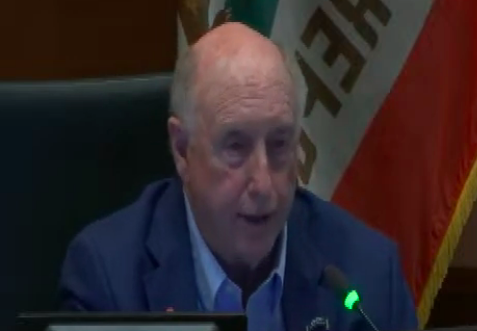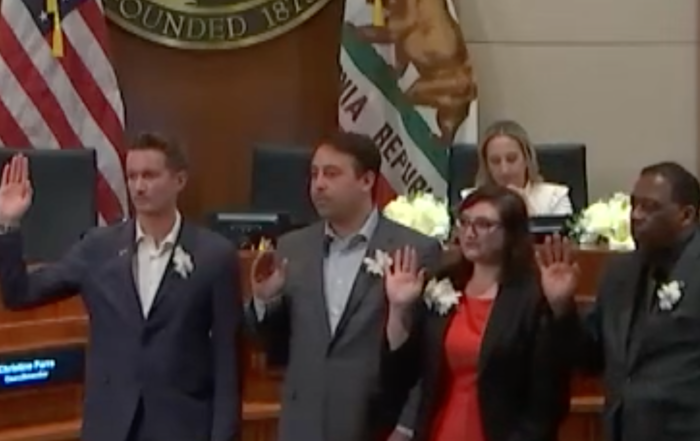On Tuesday, public safety figured heavily into the Santa Monica City Council meeting. The appearance of public safety and the reputation of the city garnered the most discussion as council members weighed in on an inflammatory banner and attendant anxieties around people experiencing homelessness.
A banner on the Third Street Promenade in Downtown Santa Monica united the council in an unusual display of solidarity. The banner has existed in various forms since 2022 and its messages have centered around L.A. County’s harm reduction program which operates for just a couple hours a week at a single park in Santa Monica. The banner currently reads “Santa Methica is Not Safe” and ties City Manager David White to the county’s safe needle exchange program, which the city thoroughly denies. Santa Monica Coalition, the group behind the banner, has largely mirrored the stigma-laden rhetoric of groups that are trying to ban harm reduction services across the state.
The L.A. County Department of Health provides harm reduction services in Santa Monica. They provide life-saving opioid overdose reversal doses, hygiene kits, and operate a needle exchange program. They also provide harm reduction education and referrals for substance abuse treatment.
The council members voted unanimously to draft a resolution that conveys the council’s disapproval of the banner’s message, notes its false claims about the city and city employees, and its harmful impact on the city’s economic recovery and public image. The resolution does not dictate the banner’s removal.
While some supporters of the banner claimed the council was violating the First Amendment, City Attorney Doug Sloane clarified that the resolution did not include directives to censor or remove the banner. Council members agreed that they were exercising their own right to free speech with this motion.
Mayor Phil Brock delivered a message to the owner of the banner, one of the more visible leaders of the Santa Monica Coalition, John Alle: “You’re discouraging your neighbors from being able to lease their space, you’re discouraging your neighbors from being able to make a living… Your ire should be directed at the county, the state, the federal government,” he said. Brock also alleged that John Alle was leading others to erroneously believe the Promenade was unsafe. “I feel safe on the promenade, my significant other Kathy feels safe… we’re there at night, we’re there in the daytime. I would appreciate it very much if you removed that sign.”
The current version of the banner uses a rainbow flag as the background for a picture of City Manager White. It also says “Sponsored by the Gay and Sober Santa Monica” – a detail which has not escaped the attention of the press. Councilmember Caroline Torosis likewise questioned the intention of associating the harm reduction program with LGBTQ+ iconography. Torosis said her husband inquired with the national Gay and Sober organization about the apparent sponsorship. The organization said that it had no such chapter in Santa Monica and was sending a cease and desist to the party responsible for the banner.
While they united under the disapproval of the banner, Brock, Vice Mayor Lana Negrete, and Councilmembers Oscar de la Torre and Christine Parra all recently attended an anti-harm reduction rally hosted by the Santa Monica Coalition. These four also voted to send a letter to the county demanding an end to the harm reduction services in the city. They said they supported the services provided but didn’t want them to be provided in public spaces.
Moving the program to a less accessible location would certainly reduce its efficacy. The L.A. County Department of Public Health, in response to pushback on its operations in Santa Monica, said, “Because harm reduction services often engage people who do not always pursue health or social services and who are at increased risk of experiencing overdose, including people experiencing homelessness, it is a well-established best practice to provide mobile harm
reduction services directly to people where they physically are.” The department estimates that through its distribution of naloxone, which reverses opioid overdoses, it prevents 12 overdoses in Santa Monica every month.
What appears to be the central issue for some council members is that people are visibly receiving care. The banner debate speaks to the same anxiety – the public perception of safety and its cumulative effect on the city’s economy. Buttressing the appearance of public safety was one of the central concerns of Mayor Brock on Tuesday.
The council also voted on changes to the city’s biennial budget, including providing more funding to the Santa Monica Police Department (SMPD) for the hiring of four additional officers.
$1 Million, the approximate cost of hiring four police officers, will be budgeted instead of the annual sidewalk and alley repavement. The salaries will eventually be paid by funds taken from the citywide facilities maintenance fund. With the addition of these four positions, the department will have 20 vacant positions.
Despite these vacancies, Brock submitted a motion in the 11th hour to cut four percent of non-personnel funds from the city’s General Fund and redirect it to the hiring of even more police officers. Brock introduced the motion after the council had spent more than an hour discussing the city’s biennial budget and capital improvement plans, derailing the meeting for another hour as council members and White tried to piece together the mayor’s plan. Another motion from Brock, one that would introduce a parcel tax measure to raise $7.5 Million for the police department and private security forces, had been withdrawn from the agenda at the beginning of the meeting.
55 officers have been added to SMPD in the past two years. Crime has not dramatically increased or decreased in Santa Monica since 2019. According to reports from SMPD, there have been fluctuations over the years. The infusion of millions of dollars into SMPD’s budget did little to change the outcomes.
Brock and others have interpreted anecdotal reports of violence and property crimes as justification for the immediate hiring of more police officers. Within the same speech, Brock seemed to contradict himself, saying a violent attack at the beach on Monday “Could not have been prevented even if we had a policeman every 100 feet along the beachfront. We understand that.” Brock said the city was obligated to respond to what he perceived was a pronounced level of fear and worry around public safety – particularly his constituents’ fears of violence committed by people experiencing homelessness.
According to the Homelessness and Housing Initiative at UC San Francisco, “Exaggerated attention on rare violent incidents that individuals experiencing homelessness commit (and emphasizing their housing status)” leads to the criminalization of homelessness. Criminalization “Diverts resources, worsens impoverishment, increases incarceration,” and increases barriers to housing. “Fear of people who are homeless, rather than compassion on their behalf, contributes to dehumanization—seeing them as less than and not deserving of our protection, care, or equitable policies. These fears, in turn, contribute to violence against people without homes—rates that appear to be rising—and lessen political will toward lasting solutions.”
People experiencing homelessness are far more likely to be victims of violent crime than they are to commit violent crime. They are less likely to commit violent crimes than people who are housed. A recent study conducted in L.A. County found that people experiencing homelessness regularly endured high levels of discrimination and violence.
According to last year’s count, 926 people experiencing homelessness lived in Santa Monica. In that same year, the Santa Monica Police Department (SMPD) reported that 1,840 arrests made that year had been of people experiencing homelessness – comprising two-thirds of its total arrests.
SMPD’s Homeless Liaison Program (HLP) and Directed Action Response Team (DART) have been deployed to clear encampments, issue citations, and arrest people.
Councilmembers questioned the efficacy of solely devoting funds to police hiring if the overall objective was responding to the housing crisis.
“With all due respect Mr. Mayor, this is a little performative,” Councilmember Gleam Davis said, noting that staffing shortages at SMPD made the mayor’s plan and his apparent urgency unrealistic. “We know that police may not be the best way to intervene for homeless individuals,” she said, noting that resources like mental health professionals and the Community Response Unit would be more appropriate investments. “We need to be responsive to the community but we also need to be thoughtful.”
Santa Monica launched the Community Response Unit (CRU) in 2021. The CRU, a van staffed by firefighters with “Specialized training in mental health emergencies, crisis communications, de-escalation, and substance use disorders” was created as an alternative to the typical police and fire department response to less serious 9-1-1 calls. Councilmember Negrete said Brock’s motion wasn’t comprehensive enough, as it excluded all alternatives like the CRU. The CRU had never been fully supported or funded, she said.
It’s unclear exactly where Brock thought the four percent budget cut should come from. Council members expressed concern about the vagueness of the motion and the incomplete picture they had of potential consequences to other departments citywide.
Councilmember Jesse Zwick said the late introduction of Brock’s motion made a thoughtful and informed vote implausible. With so many vacant positions in the department already, he said, there was no need to rush through a motion without thoroughly considering the implications. “Respectfully, if you wanted this to happen tonight you should have been prepared to tell us what you wanted to cut,” Zwick said.
“I think forcing things down everyone’s throat when we haven’t had the opportunity to look at the tradeoffs is detrimental to our governance,” Councilmember Torosis said.
Every council member except for Brock voted no on the motion. A substitute motion, planning a comprehensive study session on all public safety budgeting was scheduled for September.
Photo of Phil Brock by Screen Capture from YouTube.
Stay informed. Sign up for The Westside Voice Newsletter
By clicking submit, you agree to share your email address with Westside Voice. We do not sell or share your information with anyone.








